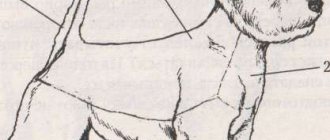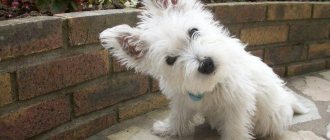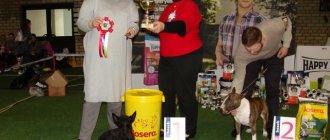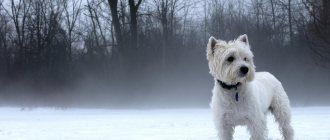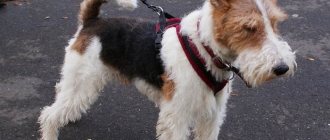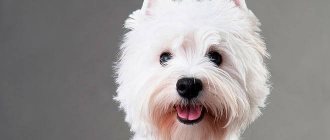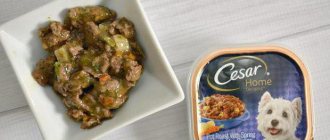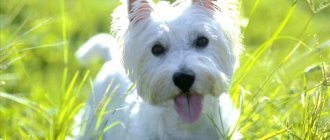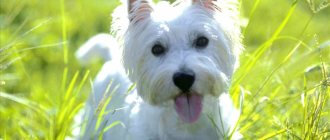West Highland White Terrier, briefly about the breed.
West, Westie, Westie, West Highland White Terrier or West Highland White Terrier. That's how many names people have come up with for this little white dog - the embodiment of terrierism.
Assertiveness, determination, sparklingness and devotion are the character and temperament traits of all terriers.
West Highland White Terriers are primarily known for their work in Scotch whiskey advertising. The snow-white fur of these dogs is a kind of symbol of purity and reliability.
Country of origin.
Westies come from the highlands of western Scotland, from Argyll, patronage - Great Britain.
History of the breed.
The breeders of this breed were the Malcolm family (Scotland), whose members noticed that in Cairn Terrier litters there were sometimes puppies with an unusual white coat color.
As a result of systematic selection, a special breed was developed, individuals of which were initially used as rat catchers. Classification.
FCI: Group 3, Section 2 - Small Terriers.
General appearance, constitution and format.
West is a handsome, pure white terrier with black eyes, nose, paw pads and claws.
It looks contrasting and very cute. The dog's head appears large and round due to its hairstyle - the cap on its head looks like a chrysanthemum. The dog has a strong type of constitution with well-defined muscles, square format. The head is set high and proportional to the body. The skull is wide. The forehead is slightly convex, the brow ridges are emphasized. The transition from forehead to muzzle is sharp. Nose and lips are black. The ears are small, erect, pointed, set wide and high, and cannot be cropped. The back is short and straight. The tail is straight, rises above the line of the back when moving, is not docked and sticks out cheerfully like a carrot. . Deep chest Height and weight according to breed standard.
Height at the withers is 23-30 cm, weight 6-10 kg.
Features of behavior and character.
West is an active, alert, courageous, confident and friendly dog.
They love to participate in active games, are hardy, and don’t mind walking in the cold for more than one hour. Obedient, not prone to aggression. They are excellent hunters with a strong pursuit instinct, so they can chase after a cat or rodent on a walk. They love to dig. Health.
They are distinguished by good health, but 20% of individuals have an excessive tendency to skin diseases and allergies.
Carefully research the puppy's pedigree when purchasing. Often there is the formation of tartar and inflammation of the gums, which requires preventive measures - regular teeth brushing. Life expectancy is about 14 years. Wool.
The Westie's coat should be thick, double, and pure white. Guard (decorating) hair up to 5 cm long, hard, tight, straight. The undercoat is thick and soft. The fringes may be a little softer and longer, but not fluffy. Thin, soft, wavy, fluffy coat that cannot be trimmed are defects.
Western boys haircuts
Although cutting a West hairstyle at home is a fairly simple procedure, it will be difficult to do it perfectly without special skills. Therefore, it is better to either go to a salon or take a grooming course that teaches you how to do professional haircuts for dogs.
A West boy named Giovanni (after a haircut at the Behemoth salon).
Haircut for West boy Leo.
Summer haircut for West Highland White Terrier.
Boy Denny, photo after grooming.
Photo of the haircut of a West Highland dog named Richie.
Photo of a Vesti boy's Amiga haircut (at the “Together with Vesti” salon).
We've seen examples of boys' haircuts, now let's see how dog owners cut their Westie girls' haircuts. By the way, there are even more photos of the boys below, in the “before and after haircut” section.
Grooming Vesta
Any dog needs grooming - care. Conventionally, West Highland Terrier grooming can be divided into several types:
- Hygienic grooming.
It is necessary for all Westies and should be carried out regularly by dog owners or in a pet salon. Bathe your dog as the coat gets dirty, using special cosmetics. After bathing, dry the coat thoroughly with a towel and hairdryer, and comb. Comb the coat daily with a comb or slicker, especially on the legs, skirt, armpit and groin folds, avoiding the formation of tangles. Westies are intolerant of pain! Trim nails and remove excess hair from paw pads once every 4-6 weeks. Wipe your ears with a special product. Monitor the condition of the paraanal glands and teeth. It is advisable to carry out preventive teeth cleaning with paste and brush weekly. - Grooming with trimming for West Highland White Terriers who do not attend exhibitions.
This type of trimming is recommended for dogs with coarse hair, for whose owners it is important to maintain its correct structure in the future. The hard coat of the Westa is brighter, straighter, adheres tightly to the skin, does not tangle, gets dirty slowly and dries quickly. Such grooming should be carried out at least 4 times a year or every 2-3 months. You will see for yourself by the condition of the dog that grooming is already necessary. The back, neck, shoulders and hips, and tail of the dog are trimmed according to the diagram given below and sometimes trimmed with a clipper to avoid bristling. The hair on the head, face, legs and belly is cut to length taking into account the wishes of the owner, but usually they try to follow the contours of the breed. - Grooming with haircut for Westies who do not attend exhibitions.
This is a type of grooming for those owners who do not trim their West Highland, but simply cut it with a clipper. This practice does change the rough texture of the dog's coat, but the truth is that not all Westies are hard. After systematic haircuts, without trimming, the Westie's coat can become thin, wavy, and plump. However, this method is the least budget- and labor-intensive. It is suitable for older dogs, for dogs with atypical, out-of-breed hair that is difficult and painful to trim. If you follow the rules of grooming that take into account breed standards, then an inexperienced observer will never understand whether the dog is being trimmed or cut. West will be beautiful after the master’s work in any case! - Exhibition grooming of a West Highland White Terrier
involves exclusively trimming the dog's back, tail, neck, shoulders and hips and trimming the dog's legs, skirt, head and muzzle according to a certain pattern. Whether it will be only pre-show trimming, which we think is not correct, or you will keep the dog in rolling (creating layers, trimming every 3-4 weeks) - the ideal option is when the dog is always ready for a show, it’s up to you to decide. But more on that below.
Western girls haircuts
A girl named Olivia, after a range of trimming services.
Girl Bonya after a haircut.
Photo of a Vesta girl named Nordika after her haircut.
A beautiful Westie named Xanthi.
West Highland White Terriers are very active dogs; after all, the breed was bred as a hunting dog. The longer and thicker the fur of an active pet, the more dirty it will get when walking outside. This is another reason to trim your Westie regularly.
The perfect combination of haircut and trimming
The calling card of the breed is the “chrysanthemum” head, relatively long hair on the paws and belly. You can achieve straight, hard guard hair and dense undercoat by alternating procedures and tools on different parts of the body.
To participate in exhibitions, Vestika can be entrusted to the care of a professional. But with the proper experience, every dog owner will be able to maintain their pet’s coat in perfect condition.
Photos of West Highland White Terriers before and after haircut
Photos of a Westie before and after a haircut (at the Khvostovil pet salon).
Doggie Westik Cupcake, before and after the complex with trimming (master - Irina, pet salon "Khvostovil").
Photo of Vesta Littlefoot before and after a haircut (at the Behemoth salon).
Boy Cedric after trimming (photo from the Behemoth pet salon).
West Highland White Terrier named Casper (photo from the Behemoth salon).
Photo of the boy Giovanni before and after his haircut.
West Ozzie before and after trimming.
Features of a clipper haircut
It is not recommended to clip the West White Terrier, especially during puppyhood. This procedure disrupts the structure of the coat and it is very difficult to restore it later: this is done using trimming in several stages.
Experienced dog breeders only recommend pinching. But if the first trimming is carried out professionally, subsequently the animal can sometimes be shaved in the neck and chest area. Trimming is an artificial shedding in which, with the help of a groomer, the dog is freed from dead hair.
Video: white terrier grooming lessons
You can see how the West Highland White Terrier is groomed in the video below, which was filmed at the Chara pet salon. On it, the master gives the dog trimming and a muzzle cut.
Also, this video is a clear example of why it is necessary to carry out regular haircuts for Westies. The difference in how a pet looks before and after grooming procedures is huge.
In the second video you can look at the result of West groom trimming from groomer Olga Cherpak. After the procedure, the fur looks much more beautiful and well-groomed.
This concludes our selection of photos of West Highland White Terriers haircuts. We hope it was interesting and you found ideas on how to trim your pet!
West Terrier Grooming Scheme
Dogs of the West Highland White Terrier breed have white, medium-length, hard fur. The undercoat is soft and furry. Animals do not shed and have almost no smell. Grooming should be carried out once every two months, for show dogs - every 30 days.
Grooming a West Highland White Terrier is regular grooming for the dog, including a regimen of hygiene procedures from ears to tail. Not all manipulations need to be done every day.
Grooming (stripping)
The West Highland White Terrier breed requires careful grooming. Natural shedding is difficult for wire-haired dogs. Coarse hair prevents the dead, delicate undercoat from falling out. During the shedding period of a West Terrier, stripping is one of the ways to help get rid of unnecessary hair. This is plucking wool using a special knife - a stripper.
Expert opinion
Anna Abramenko
An avid dog lover. Experience in veterinary medicine since 2009.
Ask a Question
It is recommended to accustom a puppy to stripping from the age of 3–4 months. The procedure is carried out with dry hair, so the dog is bathed after plucking. Starting from the age of eight months, stripping is carried out regularly and in full.
Remember! Untimely removal of dead hair retains moisture and prevents the skin from being ventilated.
Ear sanitation
Ears should be cleaned once a week. First, pluck out any long hair that appears with your fingers. Then remove dirt from the shells using ear sticks. It is advisable to carry out the procedure after the dog has taken a bath. Treat your fingers with an antiseptic, for example, boric acid.
Teeth cleaning
Brush your teeth 2 times a week. To do this, use a special dog brush and toothpaste. Introduce solid foods into the diet for self-cleaning, and allow teeth to be chewed to prevent the formation of tartar.
Claw treatment
Dogs' claws grow throughout their lives. They need to be cut when they become quite long, as they bend. It is important not to touch the pulp, which is filled with blood vessels and nerve endings. Experienced dog breeders teach puppies to have their nails trimmed from infancy.
Eye care
The eyes need to be examined every day. Dark circles that appear indicate an allergic reaction. Also, darkening around the eyes, suppuration and increased tearfulness indicate a dog’s illness. In this case, you should contact your veterinarian.
Expert opinion
Anna Abramenko
An avid dog lover. Experience in veterinary medicine since 2009.
Ask a Question
Rinse eyes with a weak solution of boric acid from the outer corner to the nose. Carefully cut off interfering regrown hair with sharp scissors. To remove mats under the eyes, use a medium-hard toothbrush. First, sort out the crumpled fur with your fingers and then comb it. Before the procedure, it is advisable to scald the brush with boiling water.
Combing
This procedure is carried out every 5–6 days. To do this, use a metal comb with wide teeth, which will remove dirt and not tear the undercoat. If the dog's fur is soft, then it needs to be scratched more often, otherwise tangles will appear.
Important! After feeding, it is recommended to wipe the animal’s face with a napkin so that food remains do not get stuck in the fur and do not change its snow-white color.
Bathing
Wash your dog once a month in warm water with the addition of zoo shampoo. Do not use soap or detergents on people. Whitening shampoos can be used, but only for adult dogs. In puppies, this composition can ruin the structure of the coat. Shampoos designed for wire-haired dogs are suitable for bathing.
After a walk, it is recommended to wash your paws with warm water. In winter, still lubricate with vegetable oil.
Expert opinion
Anna Abramenko
An avid dog lover. Experience in veterinary medicine since 2009.
Ask a Question
The snow-white fur turns yellow when saliva and food get on it. To preserve the unique white color, you need to treat it for an hour and a half with a mixture of crushed chalk and boric acid. Lightly moisten the wool, then rub in the mixture. Brush out the remaining chalk with a hair brush.
Carefully! Coat color can be affected by products containing dyes. Usually the undercoat takes on a yellowish tint. If the dog participates in shows, this may affect the ratings.
What you need to know about haircuts?
Before shortening the length of the coat with scissors, the dog must be thoroughly combed. The haircut is best used only in sensitive areas. Then the rest of the hair will remain stiff and will easily allow you to form a vestik hairstyle.
Although the fur of representatives of this breed grows quickly, you should not leave less than 1 cm on the pet’s face. Severely shortened hair will not provide the animal with reliable protection from UV rays and cold.
Basic rules of trimming
If you decide to pluck your hair yourself, you need to approach the procedure responsibly. To avoid causing unnecessary discomfort to your puppy, you should:
- Remove undercoat and some dead fur using a roller.
- Treat the hairs with baby powder to prevent them from slipping in your hands.
- Start with the spine area as this is where the fur grows fastest.
- Gently grab a fold of skin with one hand, and with the other, pluck out long hairs one by one with a sharp movement.
- Brush your pet regularly to see the results of your labor.
If there is a lack of time or before an important competition, it is better to entrust trimming to a familiar master, as in the video.
Then the wool will have an attractive appearance and the desired stiffness.
